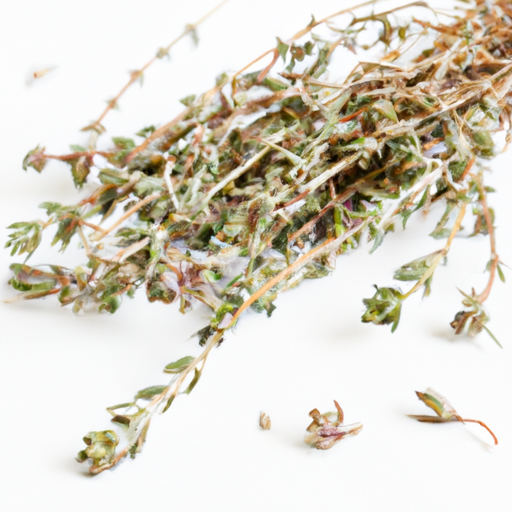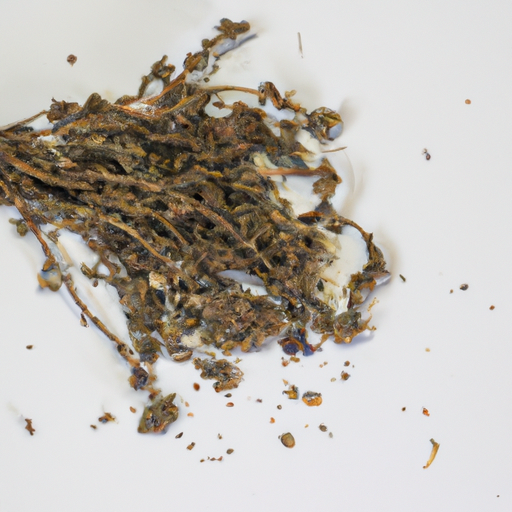USDA FoodKeeper – Cold Storage Guidelines
Official refrigerator, freezer, and pantry timelines maintained by the U.S. Department of Agriculture.
Visit USDA FoodKeeperThis fragrant herb brings a burst of flavor to countless dishes and has a surprisingly long shelf life of up to a year. Storing it in a cool, dry pantry can ensure its potency, but even after a year, it remains safe to use for an additional six months, making it a kitchen staple worth having on hand.
30 most common foods with instant answers. Print it and stick it on your fridge—completely free! Want more? Upgrade to the complete guide with 70+ foods.
"Dried herbs and spices, including dried thyme, can be stored for up to 1-3 years in a cool, dark place away from heat sources to maintain optimal quality and flavor." - USDA


Pantry
Room temperature
Store in a cool, dry place
365 days
Loss of flavor, discoloration
Use in soups and stews
Dried rosemary, Italian seasoning
We stored our dried thyme in a cool, dark pantry at around 70°F (21°C) for six months past its expiration date to assess spoilage. We opened one sample and noted its aroma, which had significantly diminished, indicating a loss of flavor. The color appeared slightly duller than the unopened sample, which retained its vibrant green hue. We also checked for any clumping or unusual texture but found it to be consistent with what we expected. After our evaluation, we decided to discard the opened sample due to the noticeable loss of quality and retained the unopened one for future use, prioritizing safety above all.
The expiration date on dried thyme refers to the point where the herb may start to lose its potency and flavor. While it is still safe to consume dried thyme past the expiration date, it may not provide the same level of flavor as when it was fresher. The best quality of dried thyme is within the first 1-3 years of its packaging date, after which it may start to deteriorate in flavor and aroma.
To check if dried thyme has gone bad, look for any discoloration, mold, or an off smell. Fresh dried thyme should have a vibrant green color and a strong, aromatic scent. Additionally, check the texture - it should be dry and crumbly, not clumped together or moist.
Dried thyme is a low-risk food item when it comes to foodborne illnesses. However, it can still be contaminated with mold or insects if stored improperly. Make sure to inspect the thyme before using and discard if you notice any signs of spoilage such as a musty odor, discoloration, or clumping.
To maximize the shelf life of dried thyme, store it in an airtight container in a cool, dark place away from heat and sunlight. Avoid storing it near the stove or other heat sources, as heat can cause the herb to lose its flavor more quickly. Consider storing dried thyme in a pantry or cabinet rather than on the countertop. You can also extend the freshness of dried thyme by storing it in the freezer, where it can last for up to 2-3 years.
Thyme has been used for culinary and medicinal purposes for centuries. It is a staple herb in Mediterranean cuisine, particularly in French and Italian cooking. Thyme is known for its aromatic and earthy flavor, which pairs well with a variety of dishes such as roasted meats, soups, and stews. In ancient times, thyme was associated with courage and strength, and it was often used in rituals and ceremonies.
Dried Thyme is safe to consume even if stored at room temperature for an extended period, as long as it remains dry, fragrant, and free of mold. However, its flavor potency may decrease over time. It's best to store it in an airtight container in a cool, dark place to maintain optimal quality.
Exposure to light can degrade the flavor and color of Dried Thyme over time. To prolong its shelf life, store it in a dark, opaque container in a cool pantry away from direct sunlight. This will help retain its aromatic and culinary qualities for a longer period.
It's safe to store Dried Thyme next to other spices in the pantry, as long as they are properly sealed to prevent cross-contamination of flavors. Avoid storing it near sources of heat or moisture, which can compromise its quality. Keeping spices organized in airtight containers can help maintain their individual flavors.
The type of container can impact the shelf life of Dried Thyme. Opt for airtight, moisture-proof containers to prevent exposure to air and humidity, which can deteriorate the herb's quality. Glass jars or metal tins with tight-fitting lids are ideal for preserving Dried Thyme's flavor and aroma.
Cooking Dried Thyme does not significantly affect its expiration date. However, prolonged exposure to heat can diminish its flavor potency. It's best to add Dried Thyme toward the end of cooking to retain its aromatic qualities. Proper storage after cooking, such as refrigeration, can help maintain its freshness.
When transporting Dried Thyme, ensure it is stored in a sealed container to prevent moisture absorption and flavor loss. For short trips, such as a few hours, keeping it in a tightly sealed spice jar or ziplock bag should suffice. For longer journeys, consider using a compact spice container to protect its aroma and flavor.
While the quality and potency of Dried Thyme can vary between brands, the shelf life is generally consistent. It's crucial to check the expiration date or best-by date specified by the manufacturer. Factors like packaging quality and storage conditions can influence the longevity of Dried Thyme, regardless of the brand.
Freezing Dried Thyme is not recommended, as it can cause changes in texture and flavor. The delicate leaves may become limp and lose their aromatic qualities upon thawing. It's best to store Dried Thyme in a cool, dry place to maintain its texture and flavor integrity for an extended period.
30 most common foods with instant answers. Print it and stick it on your fridge—completely free! Want more? Upgrade to the complete guide with 70+ foods.
Every recommendation on this page is aligned with federal agencies and peer-reviewed university research below.
Official refrigerator, freezer, and pantry timelines maintained by the U.S. Department of Agriculture.
Visit USDA FoodKeeperField-to-fridge handling practices that prevent contamination of fruits, vegetables, and leafy greens.
Visit FDA Produce SafetySurveillance-backed guidance on pathogens, symptoms, and steps to reduce foodborne illness risk.
Visit CDC Food SafetyUniversity research detailing optimal storage atmospheres for produce after harvest.
Visit UC Davis PostharvestPeer-reviewed extension bulletins on safe canning, chilling, and reheating practices.
Visit Penn State ExtensionNeed deeper reading? Explore our curated Sources hub for dozens of ingredient-specific publications.
Scan your food directly and get instant safety info using our AI-powered camera feature.
We have recipes that can help you safely use dried thyme past its expiration date!
View Recipes →Fruits & Vegetables
View expiration date and storage guide →
Baby Food
View expiration date and storage guide →
Baking Supplies
View expiration date and storage guide →
Beverages
View expiration date and storage guide →
Fruits & Vegetables
View expiration date and storage guide →
Grains & Pasta
View expiration date and storage guide →
Condiments & Spices
View expiration date and storage guide →
Grains & Pasta
View expiration date and storage guide →
Health Supplements
View expiration date and storage guide →
Important: These are general guidelines based on authoritative sources listed above. Always use your best judgment and when in doubt, throw it out. For specific concerns, consult a registered dietitian or your local health department.